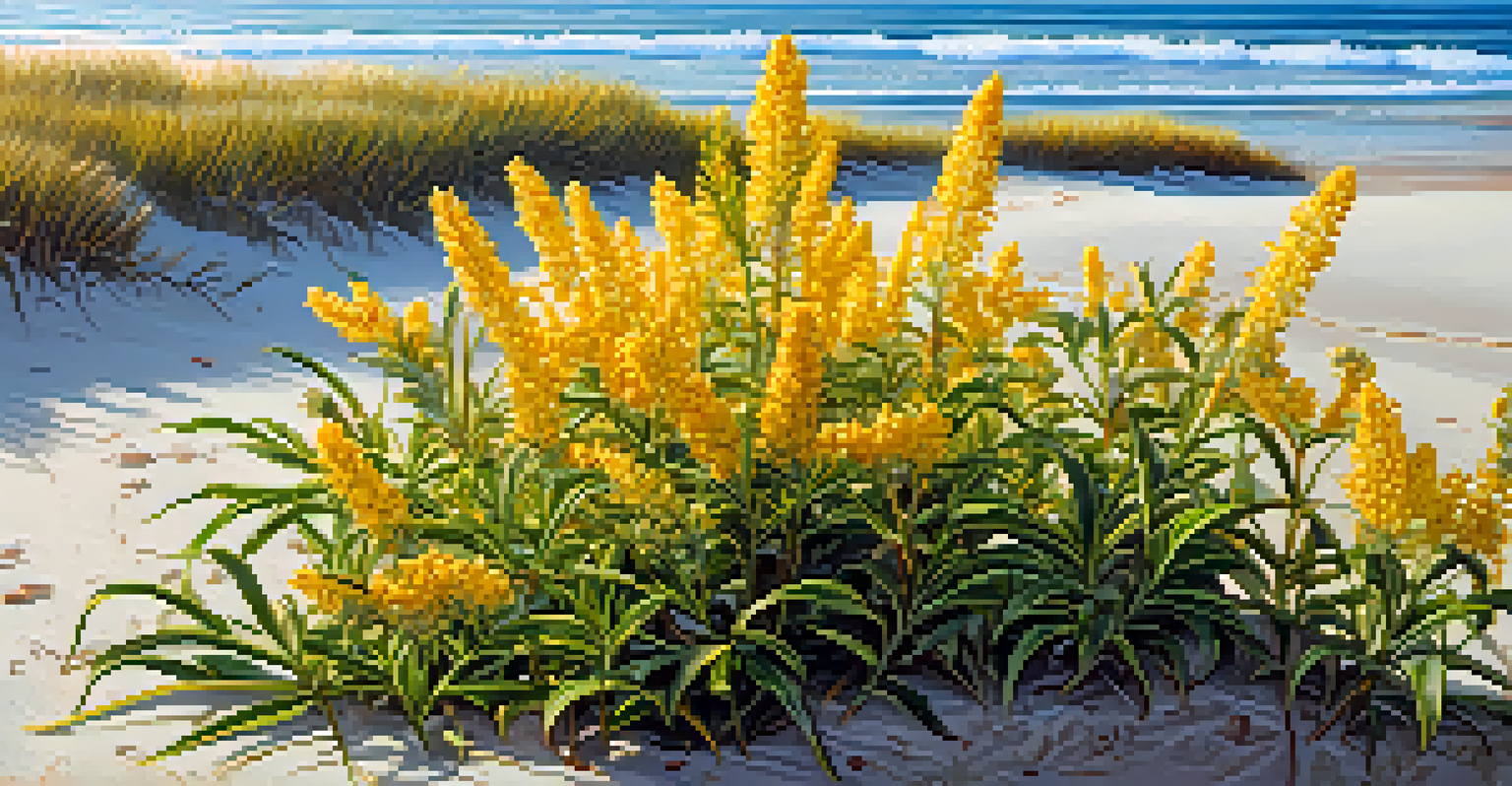Selecting Plants for Coastal Areas Facing Climate Change

Understanding Coastal Challenges in Climate Change
Coastal areas are unique ecosystems that face numerous challenges due to climate change. Rising sea levels and increased storm intensity can lead to erosion and saltwater intrusion, damaging local flora. Understanding these issues is crucial for selecting plants that can thrive despite these adversities.
Nature does not hurry, yet everything is accomplished.
Additionally, changing temperature patterns and unpredictable weather can affect plant growth cycles and biodiversity. By recognizing these factors, we can better prepare our gardens and landscapes to be resilient. It's like preparing for a storm by reinforcing your home; the same applies to our plant choices.
Ultimately, addressing these coastal challenges requires a thoughtful approach to plant selection. By choosing the right species, we can create vibrant landscapes that not only survive but thrive in changing conditions.
Choosing Native Plants for Coastal Resilience
Native plants are often the best choice for coastal areas, as they have adapted to local conditions over thousands of years. These plants can withstand salt spray, sandy soils, and the unique climate of coastal regions. By using native species, you’re not just supporting local wildlife but also ensuring that your garden requires less maintenance and water.

For example, beach grasses and coastal shrubs serve as natural barriers against erosion while providing habitats for various species. They play a crucial role in maintaining the ecosystem's balance, much like a well-placed foundation supports a house.
Choose Native Plants for Resilience
Using native plants helps create gardens that thrive in coastal conditions while supporting local wildlife.
Incorporating native plants into your coastal landscaping can lead to a more resilient garden. This approach not only enhances biodiversity but also helps combat the impacts of climate change, creating a healthier environment for both plants and animals.
Incorporating Drought-Resistant Varieties
As climate change leads to more frequent droughts, selecting drought-resistant plants becomes essential. These varieties are designed to thrive with limited water, making them perfect for coastal areas facing water scarcity. By opting for drought-resistant options, you can create a sustainable garden that minimizes water consumption.
The greatest threat to our planet is the belief that someone else will save it.
Plants like succulents and certain types of ornamental grasses not only retain water effectively but also add beauty to your landscape. Think of them as the wise savers in your garden, holding onto water just like we would hold onto our resources during tough times.
Selecting drought-resistant plants means your garden can weather dry spells without extensive irrigation. This not only saves you time and money but also contributes to a healthier ecosystem, as less water usage helps preserve local water sources.
Selecting Salt-Tolerant Plants for Coastal Gardens
Salt tolerance is a critical factor when choosing plants for coastal regions, especially near the ocean. Salt spray and soil salinity can be detrimental to many species, but salt-tolerant plants have adapted to thrive in these conditions. By incorporating these plants, you can ensure your garden remains lush and vibrant despite the coastal challenges.
Examples of salt-tolerant plants include seaside goldenrod and beach strawberry, which not only survive but can also enhance your landscape's aesthetic. Think of these plants as the resilient warriors of your garden, standing strong against the salty winds.
Emphasize Biodiversity in Gardens
A diverse range of plants enhances ecosystem resilience and supports various wildlife in coastal areas.
Integrating salt-tolerant varieties into your coastal garden is not just about survival; it’s about creating a thriving ecosystem. These plants can help stabilize soil and prevent erosion, contributing positively to the coastal environment.
Emphasizing Biodiversity in Plant Selection
Biodiversity is crucial for creating resilient coastal ecosystems, and it starts with your plant choices. A diverse range of plants can better withstand climate stressors and support a variety of wildlife. By mixing different species, you create a balanced ecosystem that can adapt more readily to changes.
Consider incorporating a mix of flowering plants, grasses, and shrubs that thrive in coastal conditions. This is akin to a diverse team in a workplace, where each member brings unique skills that together lead to success.
Encouraging biodiversity in your coastal garden not only enhances its beauty but also contributes to its overall health. A varied landscape is more resilient, providing habitats for pollinators and other wildlife that are essential for a thriving ecosystem.
Planning for Seasonal Changes in Coastal Areas
Coastal areas often experience distinct seasonal changes that can influence plant growth and survival. By planning for these variations, you can choose plants that will flourish throughout the year. Understanding the seasonal cycles of your region allows you to create a dynamic garden that changes with the seasons, much like nature’s own rhythm.
For instance, selecting plants that bloom at different times can ensure that your garden remains colorful and vibrant year-round. It's like orchestrating a symphony, where each plant plays its part at the right moment for a beautiful performance.
Implement Sustainable Gardening Practices
Adopting sustainable practices like composting and mulching protects the coastal environment and promotes plant health.
Being mindful of seasonal changes also helps you anticipate potential challenges, such as frost or heavy rains. With careful planning, your coastal garden can not only survive but thrive, showcasing its beauty through every season.
Implementing Sustainable Gardening Practices
Sustainable gardening practices are essential for maintaining healthy coastal ecosystems. Techniques such as composting, mulching, and using organic fertilizers can improve soil health while reducing the need for chemical inputs. By embracing sustainability, you’re not just caring for your garden; you’re protecting the coastal environment.
For example, mulching helps retain moisture and suppress weeds, creating a healthier growing environment. It’s like giving your plants a cozy blanket that keeps them warm and nourished.

Incorporating these practices into your gardening routine not only benefits your plants but also the surrounding ecosystem. Sustainable gardening is about nurturing the earth, ensuring that we leave a thriving coastal environment for future generations.
Monitoring and Adapting to Changes Over Time
Climate change is an ongoing issue that affects our coastal ecosystems, so monitoring and adapting your plant choices is crucial. Regularly assessing the health of your plants and the overall landscape can help you identify any changes that need to be made. Just as we adapt our lifestyles to new circumstances, so too should our gardens adapt to changing conditions.
For example, if certain plants struggle to thrive due to increased salinity or drought, it may be time to replace them with more resilient varieties. This proactive approach ensures your garden continues to flourish, much like adjusting your sails when the wind changes direction.
Staying informed about local climate trends and plant behaviors can help you make better decisions for your coastal garden. With ongoing attention and adaptability, you can cultivate a landscape that not only survives but also flourishes amidst the challenges of climate change.